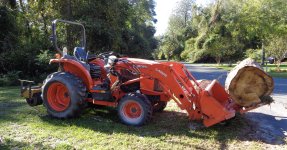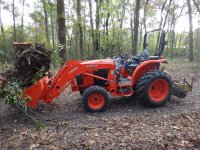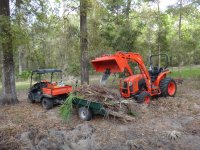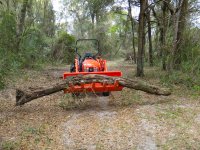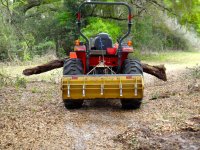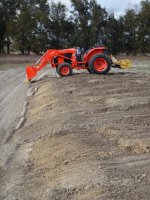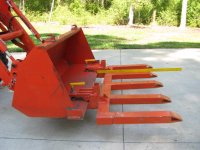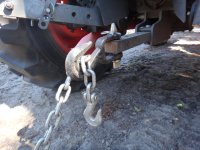jeff9366
Super Star Member
- Joined
- Jan 14, 2011
- Messages
- 12,391
- Tractor
- Kubota Tractor Loader L3560 HST+ ~~~~~~~~~~~~~ 3,700 pounds bare tractor, 5,400 pounds operating weight, 37 horsepower
I have owned three tractors, each heavier than the former. All have had tires filled only with air.
My Kubota L3560 has a modest 37-horspower. Deere 4320 has modest horsepower too. You will not need loaded rear tires for tire traction, only for stability.
Only rear tires are ballasted. Front axle is too light and pivots, so fronts are not ballasted. Power steering is not designed for loaded front tires.
Rear tires are always ballasted 3/4 full for tractor work on slopes. This lowers tractor center-of-gravity on slopes. Liquid covers internal hub so hub is continually submerged. Tractors have no suspension other than air in the tires. If tires are filled 100% ride is terrible and traction degraded because rear tire flex is degraded.
If you buy a high powered tractor, say 4,000 pound bare tractor with 60-horsepower engine, loading tires will improve traction pulling Three Point Hitch ground contact implements such as a quadruple plow or heavy, wide Disc Harrow. Alternative is bolt-on cast iron wheel weights for traction on level ground. Sometimes both liquid and wheel weights are installed. Liquid and cast iron have advantages/disadvantages to each. But for slopes, to improve stability, 3/4 liquid is better than cast iron.
If you run tractor over hard surface roads at high speeds, 14 to 18 miles per hour, loaded rear tires (1,400 pounds) can negatively influence handling and braking, requiring extra caution as liquid falls.
If you get a puncture, you lose the liquid. Changing liquid filled rear tires is at least a two person, sweaty, potentially hazardous job @ 700 pounds per rear wheel.
All three of my tractors have had rear tires filled only with air. By design, I minimally compact soil; a tenant of sustainable agriculture. When I need ballast weight I mount a Cultipacker or Box Blade on the Three Point Hitch for counterbalance. My Three Point Hitch weight can be removed. Weight cantilevered on the Three Point Hitch is more effective counterbalance weight than rear tire weight on the rear axle.
A heavy tractor with air filled R4/industrial rear tires may still traverse lawns in 2-WD without marking; loading the rear tires usually marks/ruts lawns. ( I never mark/rut lawns with my 5,400 pound kubota L3560 with air filled R4/industrial rear tires in 2-WD.)
Rear tire chains, rubber or steel, are a neglected option for improving tire traction in fields. I have no experience with chains as my tractor has a modest 37-horsepower engine. However, T-B-N correspondents who use tire chains are fans.
You will need Three Point Hitch implements. Heavy implements are excellent counterbalance as they are cantilevered to rear of tractor, increasing effectiveness of nominal weight. Cantilevered rear weight unloads FEL load stress from front axle and front axle bearings; filled rear tire weight does not.
I keep a 600 pound Cultipacker on the Three Point Hitch most of the time. Cultipacker is my usual choice because it is compact. When I need to lift heavy FEL loads I mount 600 pound Box Blade, which protrudes further to the rear,
or 950 pound Disc Harrow which protrudes way.......back there, reducing maneuverability but permits 1,600 pound lifts my FEL is capable of.
Photo #5 is around 1,600 pound lift. Rear wheels may have had 200 pounds ground contact.
Tractor reliability is primarily a factor of prudence and experience of the operator. I operate my FEL at no more than 60% of capacity most of the time. You read here often: BUY ENOUGH TRACTOR. Buy enough tractor so you operate at no more than 60% of capacity most of the time, 100% only occasionally.
Heavy tractor, long life. Safety first.
Photo #7 Ratchet Rake grading.
MORE: http://www.tractorbynet.com/forums/...386705-kubota-l3560-tractor-la805-loader.html
My Kubota L3560 has a modest 37-horspower. Deere 4320 has modest horsepower too. You will not need loaded rear tires for tire traction, only for stability.
Only rear tires are ballasted. Front axle is too light and pivots, so fronts are not ballasted. Power steering is not designed for loaded front tires.
Rear tires are always ballasted 3/4 full for tractor work on slopes. This lowers tractor center-of-gravity on slopes. Liquid covers internal hub so hub is continually submerged. Tractors have no suspension other than air in the tires. If tires are filled 100% ride is terrible and traction degraded because rear tire flex is degraded.
If you buy a high powered tractor, say 4,000 pound bare tractor with 60-horsepower engine, loading tires will improve traction pulling Three Point Hitch ground contact implements such as a quadruple plow or heavy, wide Disc Harrow. Alternative is bolt-on cast iron wheel weights for traction on level ground. Sometimes both liquid and wheel weights are installed. Liquid and cast iron have advantages/disadvantages to each. But for slopes, to improve stability, 3/4 liquid is better than cast iron.
If you run tractor over hard surface roads at high speeds, 14 to 18 miles per hour, loaded rear tires (1,400 pounds) can negatively influence handling and braking, requiring extra caution as liquid falls.
If you get a puncture, you lose the liquid. Changing liquid filled rear tires is at least a two person, sweaty, potentially hazardous job @ 700 pounds per rear wheel.
All three of my tractors have had rear tires filled only with air. By design, I minimally compact soil; a tenant of sustainable agriculture. When I need ballast weight I mount a Cultipacker or Box Blade on the Three Point Hitch for counterbalance. My Three Point Hitch weight can be removed. Weight cantilevered on the Three Point Hitch is more effective counterbalance weight than rear tire weight on the rear axle.
A heavy tractor with air filled R4/industrial rear tires may still traverse lawns in 2-WD without marking; loading the rear tires usually marks/ruts lawns. ( I never mark/rut lawns with my 5,400 pound kubota L3560 with air filled R4/industrial rear tires in 2-WD.)
Rear tire chains, rubber or steel, are a neglected option for improving tire traction in fields. I have no experience with chains as my tractor has a modest 37-horsepower engine. However, T-B-N correspondents who use tire chains are fans.
You will need Three Point Hitch implements. Heavy implements are excellent counterbalance as they are cantilevered to rear of tractor, increasing effectiveness of nominal weight. Cantilevered rear weight unloads FEL load stress from front axle and front axle bearings; filled rear tire weight does not.
I keep a 600 pound Cultipacker on the Three Point Hitch most of the time. Cultipacker is my usual choice because it is compact. When I need to lift heavy FEL loads I mount 600 pound Box Blade, which protrudes further to the rear,
or 950 pound Disc Harrow which protrudes way.......back there, reducing maneuverability but permits 1,600 pound lifts my FEL is capable of.
Photo #5 is around 1,600 pound lift. Rear wheels may have had 200 pounds ground contact.
Tractor reliability is primarily a factor of prudence and experience of the operator. I operate my FEL at no more than 60% of capacity most of the time. You read here often: BUY ENOUGH TRACTOR. Buy enough tractor so you operate at no more than 60% of capacity most of the time, 100% only occasionally.
Heavy tractor, long life. Safety first.
Photo #7 Ratchet Rake grading.
MORE: http://www.tractorbynet.com/forums/...386705-kubota-l3560-tractor-la805-loader.html
===Fill in your location within your T-B-N Profile.===
Attachments
Last edited:
